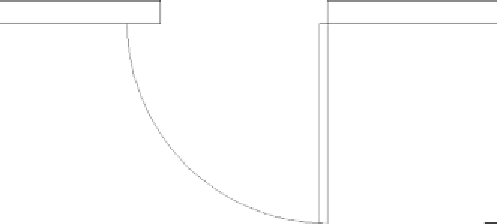Graphics Programs Reference
In-Depth Information
It may take some practice to become proficient at visualizing and designating
the mirror line, but once you're used to it, you'll have learned how to use a pow-
erful tool. Because many objects—including building layouts, mechanical parts,
steel beams, road cross sections, and so on—have some symmetry to them, wise
use of the
MIRROR
command can save you a lot of drawing time.
Now let's change the scale of the interior to match the available opening.
Scaling the Bathroom Door
You could have used the
STRETCH
command to make the door narrower, but
that's an advanced Modify command and won't be introduced until Chapter 11,
“Working with Hatches, Gradients, and Tool Palettes.” Besides, the arc would have
to be modified to a smaller radius. It's easier to scale the objects and the slightly
thinner door can be attributed to interior doors being thinner than exterior doors.
In Chapter 9, “Using Dynamic Blocks and Tables,” I'll demonstrate a
dynamic block
that can serve as a door block for several door sizes.
For this exercise, you will use the
SCALE
command to resize the bathroom
door to fit the existing opening. The
SCALE
command changes the size of all the
selected objects by an equal amount based on keyboard input or the location of
the cursor. The objects scale up or down in relation to their position relative to a
base point you've defined. Objects scaled up will appear to get farther away from
the base point while objects scaled down will appear to get closer.
The 30
″
(762 mm) bathroom door opening is 5/6 the size of the 36
″
(915 mm)
back door opening; therefore, 5/6, or its decimal equivalent of 0.8333, can be
used as the scale factor. Because fractions are inherently more accurate than
rounded-off decimal values, we'll use the fractional scale factor.
1.
Continue using
04A-FPLAY4.dwg
, or open it if it's not already open.
O
2.
Click the Zoom Window button found on the navigation bar to zoom
in to the interior door opening (see Figure 4.58).
a 762 mm door
isn't exactly 5/6 the
size of a 915 mm
door, and using the
method that follows
results in a door that
is approximately
½ mm too wide, but
that is close enough
for our purposes
here. If you prefer
to be more accurate,
substitute 0.832787
for 5/6 in step 5.
FiGuRE 4.58
A close-up view of the bathroom door



Search WWH ::

Custom Search